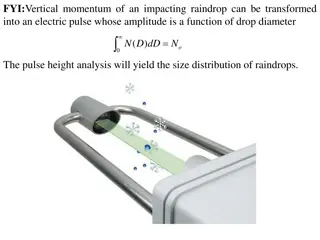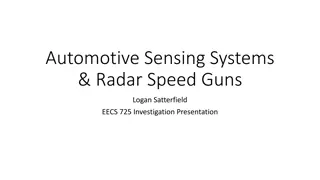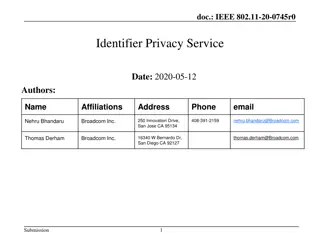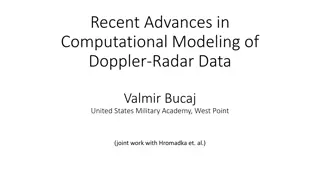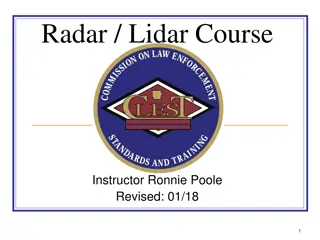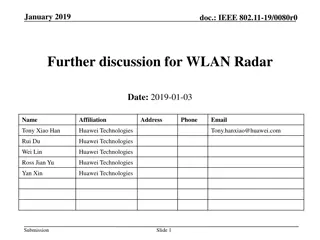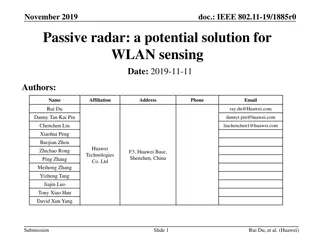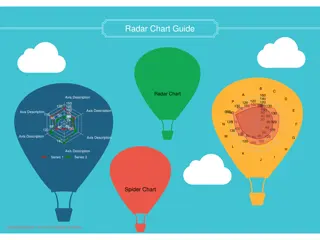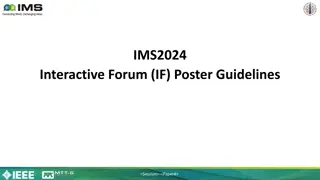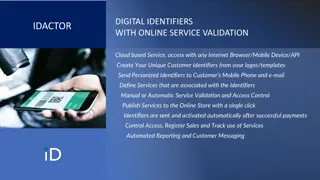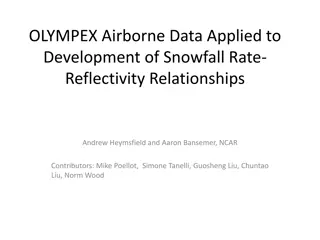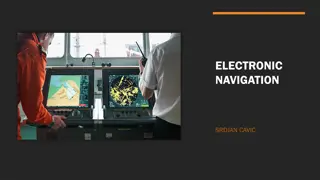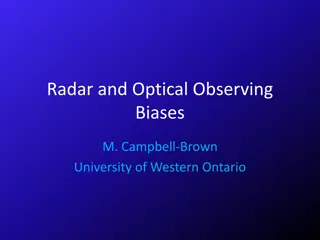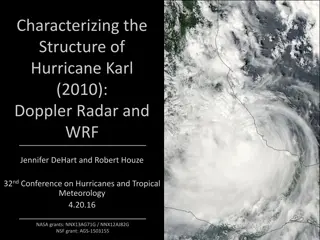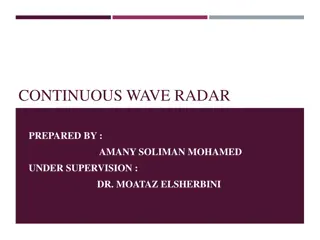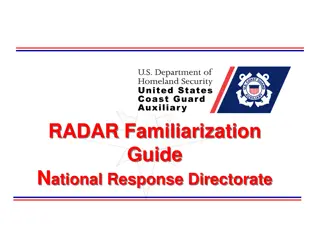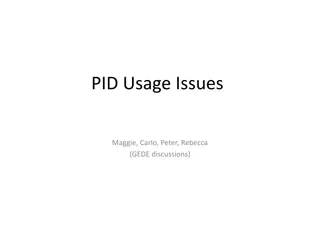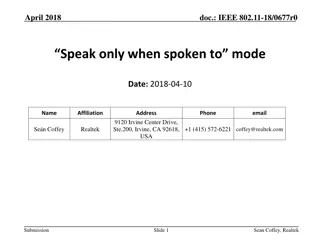Understanding Mode-S Radar Operations and Identifiers
This simplified explanation delves into the fundamental principles of radar operations, focusing on Primary and Secondary radar systems, including Mode A/C and Mode S functionalities. It covers radar interrogation, replies, and the significance of radar identifiers (II and SI codes) in managing overlapping radars. The differentiation between All-call and Roll-call interrogations, aircraft addresses, and the necessity of using SI codes in certain scenarios are highlighted. Gain insights into the working principles of radar and the associated codes critical for effective air traffic management.
Download Presentation

Please find below an Image/Link to download the presentation.
The content on the website is provided AS IS for your information and personal use only. It may not be sold, licensed, or shared on other websites without obtaining consent from the author. Download presentation by click this link. If you encounter any issues during the download, it is possible that the publisher has removed the file from their server.
E N D
Presentation Transcript
Simplified explanation of II/SI code operations Prepared for ICAO APAC Mode S and DAPS WG/6 28-30 March 2023 By HO Wee Sin Civil Aviation Authority of Singapore
Working principles of radar Primary radar only provides position of aircraft Secondary (mode A/C) radar provides the Mode A (i.e. ident code) and Mode C (barometric height), plus position Secondary (mode S) radar provides other information (e.g. unique 24-bit Aircraft address, call-sign, vertical intent etc), plus what mode A/C radar can provide. Note that mode A/C is mandatory but not mode S Primary radar Secondary radar (Mode A/C) Secondary radar (Mode S) Interrogation (all-call or roll-call) Interrogation (mode A or Mode C) Pulse sent out Pulse reflected Transponder replies with height and identity (mode A), with other information Mode A (ident) and Mode C (height) Radar measures position of aircraft *4096 mode A codes available
Broad principle for mode S Broad principle for mode S Interrogation Reply Remark Appropriate reply All-call 24-bit Aircraft address Only non-locked out aircraft will reply Interrogation (all-call or roll-call) Roll-call (to only selected aircraft) Aircraft address + height / Mode A with: Elementary Mode S a) Datalink capability report; b) Flight ID (aka call-sign); c) TCAS resolution advisory report; Enhanced Mode S a) Selected vertical intention; b) Track and turn; c) Heading and speed; Only target aircraft will reply. For purpose of locking out to all-call, each radar has its own identifier code (IC). Old scheme is the interrogator identifier (II) (15 combination). New scheme is the surveillance identifier (SI) (63 combination). Not all aircraft can recognize the SI code.
Radar identifiers SI codes has to be used if too many overlapping radars II codes can be used if not too many overlapping radars II=1 II=6 II=4 II=7 II=3 II=2 II=5
All-call 24 bit aircraft address = 76ABCD Locked out to II = 4, 7 Locked out to SI =21, 22 24 bit aircraft address = 34ABCE Locked out to II = 4 Locked out to SI =21, 22 All call interrogation All call interrogation No reply to all call interrogation from radar with II=7 Reply with 24 bit address = 34ABCE and II=7 Currently acquired aircraft 24 bit aircraft address = 76ABCD Newly acquired aircraft 24 bit aircraft address = 34ABCE Radar with II=7
Roll-call 24 bit aircraft address = 34ABCE Locked out to II = 4 Locked out to SI =21, 22 roll call interrogation to 34ABCE, with lock out command 24 bit aircraft address = 76ABCD Locked out to II = 4, 7 Locked out to SI =21, 22 Addition radar to lock out II = 7 roll call interrogation to 76ABCD, with lock out command Reply with 24 bit address with requested data Reply with 24bit address and requested data Currently acquired aircraft 24 bit aircraft address = 76ABCD, 34ABCE Radar with II= 7
Coding of the II and SI number Within the all-call interrogator message (UF=11), it contains 4 bit IC field and 3 bit CL field 4 bit IC field 3 bit CL field SI code and II codes with same IC fields are matching representing range of 0 to 15 decimal 3 bit field to represent 0 to 5 decimal E.g. II = 7 is a matching II code for SI = 23 CL field how it affects interpretation of IC field 000 (or 0 dec) IC field contains II code 0 to 15 001 (or 1 dec) IC field contains SI codes 1 to 15 010 (or 2 dec) IC field contains SI codes 16 to 31 011 (or 3 dec) IC field contains SI codes 32 to 47 100 (or 4 dec) IC field contains SI codes 48 to 63 Aircraft transponder need to be SI capable to interpret CL field, else it assume CL field is 0
All-call (effects of aircraft with non-SI capable transponders) CL = 010, IC=0111, Its SI = 23 24 bit aircraft address = 76ABCD SI capable transponder 24 bit aircraft address = 34ABCE Non-SI capable transponder All call interrogation SI = 23 All call interrogation SI=23 CL = 000, IC=0111, Its II = 7 Reply with 24 bit address = 76ABCD and SI=23 Reply with 24 bit address = 34ABCE and II=7 Newly acquired aircraft 24 bit aircraft address = 76ABCD Failed to acquire 24 bit aircraft address = 34ABCE Radar with SI=23 (does not support II/SI code operations)
Work-around available (II/SI code operations) using SI codes All-call interrogations with SI codes If transponder replies with SI code, to subsequently roll-call with SI code and issue lockout command If any transponder replies with matching II code, to subsequently roll-call with matching II code and not issue lockout command
All All- -call (SI radars with II/SI code operations) call (SI radars with II/SI code operations) CL = 010, IC=0111, Its SI = 23 24 bit aircraft address = 76ABCD SI capable transponder 24 bit aircraft address = 34ABCE Non-SI capable transponder All call interrogation SI = 23 All call interrogation SI=23 CL = 000, IC=0111, Its II = 7 Reply with 24 bit address = 76ABCD and SI=23 Reply with 24 bit address = 34ABCE and II=7 Newly acquired aircraft 24 bit aircraft address = 76ABCD Newly acquired aircraft 24 bit aircraft address = 34ABCE, Noted that it is non-SI capable transponder Radar with SI=23 (radar supports II/SI code operations)
Roll Roll- -call (SI radar with II/SI code operations) call (SI radar with II/SI code operations) 24 bit aircraft address = 34ABCE Non-SI capable roll call interrogation to 34ABCE, II=7, without lock out command 24 bit aircraft address = 76ABCD SI code capable Not locked out to II = 7 roll call interrogation to 76ABCD, SI=23 with lock out command Locked out to SI=23 for future all-calls All call by other radars Reply with 24 bit address with requested data Aircraft can respond to the all-calls Reply with 24bit address and requested data Other radars with II=7 and matching SI codes Currently acquired SI transponder 24 bit aircraft address = 76ABCD Currently acquired II transponder 24 bit aircraft address= 34ABCE Radar with SI=23 (radar supports II/SI code operations)
Work-around available (II/SI code operations) using II codes All-call interrogations with II codes Roll-call to ascertain whether transponder is SI capable by requesting for BDS 1,0 If BDS 1,0 indicates that transponder is SI capable, to subsequently roll-call with II code and issue lockout command If BDS 1,0 indicates that transponder is not SI capable, to subsequently roll-call with II code and not issue lockout command Currently practised in Europe
All All- -call (II radars with II/SI code operations) call (II radars with II/SI code operations) CL = 000, IC=0111, Its II = 7 24 bit aircraft address = 76ABCD SI capable transponder 24 bit aircraft address = 34ABCE Non-SI capable transponder All call interrogation II = 7 All call interrogation II=7 CL = 000, IC=0111, Its II = 7 Reply with 24 bit address = 76ABCD and II=7 Reply with 24 bit address = 34ABCE and II=7 Newly acquired aircraft 24 bit aircraft address = 76ABCD, unknown whether its SI capable transponder Newly acquired aircraft 24 bit aircraft address = 34ABCE, Unknown whether it is SI capable transponder Radar with II=7 (radar supports II/SI code operations)
Initial Roll Initial Roll- -call (II radar with II/SI code operations) call (II radar with II/SI code operations) roll call interrogation to 34ABCE, II=7, without lock out command, request for BDS 1,0 24 bit aircraft address = 34ABCE Non-SI capable 24 bit aircraft address = 76ABCD SI code capable roll call interrogation to 76ABCD, II=7 without lock out command, request for BDS 1,0 Reply with 24 bit address and BDS 1,0 indicating its SI capable Reply with 24bit address and BDS 1,0 indicating its not SI capable Currently acquired transponder 24 bit aircraft address = 76ABCD Unknown whether 76ABCD is SI capable Note that 76ABCD is SI capable Currently acquired transponder 24 bit aircraft address = 34ABCE Noted that 34BCE is not SI capable Radar with II=7 (radar supports II/SI code operations) Unknown whether 34BCE is SI capable
Subsequent Roll Subsequent Roll- -call (II radar with II/SI code call (II radar with II/SI code operations) operations) 24 bit aircraft address = 34ABCE Non-SI capable roll call interrogation to 34ABCE, II=7, without lock out command 24 bit aircraft address = 76ABCD SI code capable Not locked out to II = 7 roll call interrogation to 76ABCD, II=7 with lock out command Locked out to II=7 for future all- calls All call by other radars Reply with 24 bit address with requested data Aircraft can respond to the all-calls Reply with 24bit address and requested data Other radars with matching SI codes to II=7 Currently acquired SI transponder 24 bit aircraft address = 76ABCD Currently acquired II transponder 24 bit aircraft address= 34ABCE Radar with II=7 (radar supports II/SI code operations)
General strategy in migration from II to SI New (remove one II code, replace with 4 SI codes, ensuring that all radars supports II/SI code operations) Existing SI=55 SI=7 II=7 SI=39 SI=23
General strategy in migration from II to SI New (there will be risk to add radars with matching SI codes without first removing the out matching II code) see next slide Existing SI=55 SI=7 II=7 II=7 SI=39 SI=23 Unknown whether the radar supports II/SI code operations
All-call (effects when radar with II/SI code operations overlaps with radar having match II code) CL = 010, IC=0111, Its SI = 23 24 bit aircraft address = 34ABCE Non-SI capable transponder, locked out to II=7 by another radar 24 bit aircraft address = 76ABCD SI capable transponder All call interrogation SI = 23 All call interrogation SI=23 CL = 000, IC=0111, Its II = 7 Reply with 24 bit address = 76ABCD and SI=23 No reply Newly acquired aircraft 24 bit aircraft address = 76ABCD Could not acquired aircraft 24 bit aircraft address = 34ABCE, Radar with SI=23 (radar supports II/SI code operations)
Conclusion These slides are meant for simple explanation of II/SI code operations. For mode details, please refer to Doc 9924 Appendix H and J.



